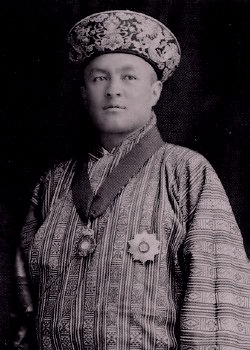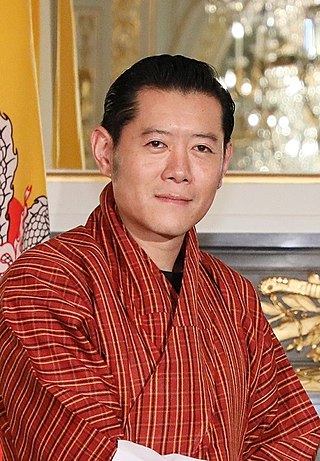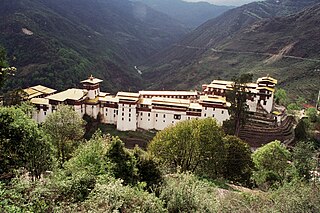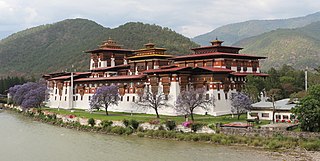Related Research Articles

Bhutan's early history is steeped in mythology and remains obscure. Some of the structures provide evidence that the region has been settled as early as 2000 BC. According to a legend it was ruled by a Cooch-Behar king, Sangaldip, around the 7th century BC, but not much is known prior to the introduction of Tibetan Buddhism in the 9th century, when turmoil in Tibet forced many monks to flee to Bhutan. In the 12th century, the Drukpa Kagyupa school was established and remains the dominant form of Buddhism in Bhutan today. The country's political history is intimately tied to its religious history and relations among the various monastic schools and monasteries.

Jigme Singye Wangchuck is a member of the House of Wangchuck who was the king of Bhutan from 1972 until his abdication in 2006.

Jigme Wangchuck was the 2nd Druk Gyalpo or king of Bhutan from 26 August 1926, until his death. He pursued legal and infrastructural reform during his reign. Bhutan continued to maintain almost complete isolation from the outside world during this period; its only foreign relations were with the British Raj in India. He was succeeded by his son, Jigme Dorji Wangchuck.

Jigme Dorji Wangchuck was the 3rd Druk Gyalpo of Bhutan.
Articles related to Bhutan include:

Dechencholing Palace is located in Thimphu, the capital of Bhutan, 4 kilometres (2.5 mi) to the north of the Tashichho Dzong and 7 kilometres (4.3 mi) north of the city centre. It was built in 1953 by the third king of Bhutan Druk Gyalpo Jigme Dorji Wangchuck.

Jigme Khesar Namgyel Wangchuck is the Druk Gyalpo, the monarch of the Kingdom of Bhutan. After his father Jigme Singye Wangchuck abdicated the throne, he became the monarch on 9 December 2006. A public coronation ceremony was held on 6 November 2008, a year that marked 100 years of monarchy in Bhutan.

The Wangchuck dynasty have held the hereditary position of Druk Gyalpo of Bhutan since 1907. Prior to reunification, the Wangchuck family had governed the district of Trongsa as descendants of Dungkar Choji. They eventually overpowered other regional lords and earned the favour of the British Empire. After consolidating power, the 12th Penlop of Trongsa Gongsar Ugyen Wangchuck was elected Druk Gyalpo, thus founding the dynasty. The position of Druk Gyalpo – who heads the royal family of Bhutan – is more commonly known in English as the King of Bhutan, however "Druk Gyalpo" would be translated literally as "Dragon King"

Penlop is a Dzongkha term roughly translated as governor. Bhutanese penlops, prior to unification, controlled certain districts of the country, but now hold no administrative office. Rather, penlops are now entirely subservient to the House of Wangchuck.
Princess AshiKesang Choden Wangchuck, is a member of the royal family of Bhutan. She is a daughter of the fourth King of Bhutan Jigme Singye Wangchuck and Queen Mother Ashi Tshering Pem Wangchuck, one of the former king's four wives, all of whom are sisters and held the title 'queen consort'. She is a half-sister of the current Druk Gyalpo Jigme Khesar Namgyel Wangchuck, who became king following the abdication of his father Jigme Singye Wangchuck on 9 December 2006.

The Penlop of Trongsa, also called Chhoetse Penlop, is a Dzongkha title meaning "Governor of the Province of Trongsa (Chhoetse)". It is generally given to the heir apparent of the Kingdom of Bhutan. The most recent holder of the title was King Jigme Khesar Namgyel Wangchuck, who was then a prince. The current heir apparent is Prince Jigme Namgyel Wangchuck, because the title is reserved for the officially designated heir apparent, and is subject to change by the reigning king. Also, the reigning Druk Gyalpo may retain the office or award it to another person after coronation. The proper reference style is His Royal Highness Trongsa (Chhoetse) Penlop.

Trongsa Dzong is the largest dzong fortress in Bhutan, located in Trongsa in Trongsa district, in the centre of the country. Built on a spur overlooking the gorge of the Mangde River, a temple was first established at the location in 1543 by the Drukpa lama, Nagi Wangchuk son of Ngawang Chhojey. In 1647, his great-grandson Shabdrung Ngawang Namgyal, constructed the first dzong to replace it, called Chökhor Rabtentse Dzong with a shorter version of Choetse Dzong. It was enlarged several times during the 18th century; the Chenrezig Lhakang was built in 1715 and a whole complex, including the Maitreya (Jampa) temple, was added in 1771. The dzong has since been repaired on several occasions; it was damaged during the 1897 Assam earthquake and underwent extensive renovation in 1927 and 1999.

The Punakha Dzong, also known as Pungthang Dewa chhenbi Phodrang, is the administrative centre of Punakha District in Punakha, Bhutan. Constructed by Ngawang Namgyal, 1st Zhabdrung Rinpoche, in 1637–38, it is the second oldest and second-largest dzong in Bhutan and one of its most majestic structures. The dzong houses the sacred relics of the southern Drukpa Lineage of the Kagyu school of Tibetan Buddhism, including the Rangjung Kharsapani and the sacred remains of Ngawang Namgyal and the tertön Pema Lingpa.
Public holidays in Bhutan consist of both national holidays and local festivals or tshechus. While national holidays are observed throughout Bhutan, tsechus are only observed in their areas. Bhutan uses its own calendar, a variant of the lunisolar Tibetan calendar. Because it is a lunisolar calendar, dates of some national holidays and most tshechus change from year to year. For example, the new year, Losar, generally falls between February and March.

Trongsa Province was one of the nine historical Provinces of Bhutan.

Bumthang Province was one of the nine historical Provinces of Bhutan.

Kurmaed Province was one of the nine historical Provinces of Bhutan.

Desi Jigme Namgyal of Bhutan is a forefather of the Wangchuck Dynasty. He served as 48th Druk Desi of Bhutan (1870–1873), and held the hereditary post of 10th Penlop of Trongsa. He was called the Black Ruler.
The Kingdom of Bumthang was one of several small kingdoms within the territory of modern Bhutan before the first consolidation under Zhabdrung Ngawang Namgyal in 1616. After initial consolidation, the Bumthang Kingdom became Bumthang Province, one of the nine Provinces of Bhutan. The region was roughly analogous to modern-day Bumthang District. It was again consolidated into the modern Kingdom of Bhutan in 1907.

Ashi Kesang Choden is the Queen Grandmother of Bhutan and the widow of the late Jigme Dorji Wangchuck. She participates in royal duties of her own accord. She is the only queen grandmother in the world. In Bhutan she is called The Royal Grandmother.
References
- ↑ Planet, Lonely. "Thruepang Palace in Trongsa, Bhutan". Lonely Planet. Retrieved 2017-11-14.
- ↑ "Trongsa | Tourism Council of Bhutan (Official Website)". www.tourism.gov.bt. Retrieved 2017-11-14.
- ↑ Bhutan, Tourism Council of. "Thruepang Palace". www.bhutan.travel. Retrieved 2017-11-06.
- ↑ Tourism Council of Bhutan. "Thruepang Palace". www.bhutan.travel. Retrieved 2017-11-14.
- ↑ Planet, Lonely; Mayhew, Bradley; Brown, Lindsay (2017-03-01). Lonely Planet Bhutan. Lonely Planet. ISBN 9781787010192.
- ↑ "Trongsa Tshechu | Tourism Council of Bhutan (Official Website)". www.tourism.gov.bt. Retrieved 2017-11-14.
- ↑ "Bhutan Cultural Atlas - Thruepang Palace". www.bhutanculturalatlas.org. Retrieved 2017-11-06.
- ↑ "Google Maps". Google Maps. Retrieved 2017-11-14.
- ↑ Tshering, Ugen. "Bhutan Festival Dates". Windhorse Tours. Retrieved 2017-11-14.